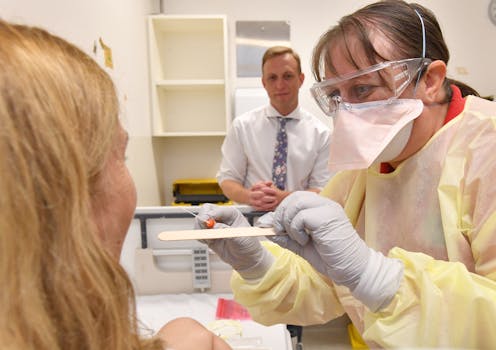Why a 'locals-first' approach doesn't work in a pandemic
- Written by Timothy Baker, Associate Professor and Director, Centre for Rural Emergency Medicine, Deakin University

Toilet paper and ventilators may be unlikely bedfellows, but they serve as powerful symbols of the growing tensions between urban and rural regions in Australia and elsewhere amid the COVID-19 pandemic.
Last month, the media reported dozens of frenetic “supermarket swoops” across the nation. Busloads of city residents converged on rural grocery stores to fill their trolleys with supplies, leaving the shelves bare for local shoppers.
As a result, supermarket managers and security guards stepped in to be custodians of the local, refusing access to those who did not look familiar.
It is important to note that “local” is a powerful cultural idea. Local shoppers don’t legally have a right to toilet paper in this instance, but there is a moral perception they should have first dibs based on their need for essential services and in the interests of social order.
No ‘locals only’ option for hospitals
The toilet paper fiasco serves as an analogy for a much graver issue as the pandemic spreads around the world.
What happens if overwhelmed city hospitals hoard the staff and resources needed to manage COVID-19, leaving rural areas to fend for themselves? Rural areas of the United States are already confronting this reality.
To compound the problem, many people have been eager to escape crowded cities like Sydney, London, New York and San Francisco for the imagined safety of the countryside. This places strain on rural healthcare providers, making it difficult to prepare for and utilise already stretched resources.
Small town health services cannot plaster “locals only” posters on their doors or allow only “familiar faces” access to lifesaving equipment.
As rural professionals in medicine, ethics and media/cultural studies, we bring an interdisciplinary perspective to the issue of local resourcing and implications for the urban-rural divide.
We understand that in a pandemic, urban health care workers would also feel a need to protect and ensure supplies at their local hospitals first. But the equity of urban-rural resourcing during the COVID-19 crisis warrants more attention.
Read more: COVID-19 may hit rural residents hard, and that spells trouble because of lack of rural health care
Big media focus on urban problems
Urban areas in Australia already have almost three times as many hospital specialists per capita as outer regional areas and many times more critical care specialists.
Our regional health systems are struggling. Many hospitals rely on fly-in-fly-out emergency, anaesthetic and intensive care doctors. These doctors (often from city hospitals on short-term contracts to fill gaps in the local roster) are now limited by quarantine restrictions. They also want to stay near their metropolitan hospitals in case they are needed.
Read more: Geographical narcissism: when city folk just assume they're better
There’s a concern that a capital city’s rush for resources could also leave patients in rural hospitals without medical necessities, similar to the panic buying of supermarket goods that has left some remote Indigenous communities without basic food and hygiene necessities.
Yet, these issues have not been discussed enough. Big media tends to focus on the impact of this health crisis on major metropolitan areas where more people live.
How we can more equitably share resources
We need a better strategy for rural-urban resource allocation during the crisis.
Nobel Prize-winning economist Amartya Sen suggests solutions may have to be tailored to specific contexts (like rural and urban settings) to be effective and ensure everyone’s health is of equal value. Drawing on his “capability approach”, we need to allocate resources in a way that is community-centred, equity-focused and puts an emphasis on deliberative democratic processes.
To hash out solutions, stakeholders in rural and urban hospitals should gather around a “virtual” table to discuss their differing needs. Government organisations and medical colleges have already begun this process.
Read more: 'Coronavirus holidays' stoke rural fury
Effective resource allocation could impact who gets critical care treatment. Centralising resources is a proven lifesaver in normal times when transport is secure, but pandemics threaten to overwhelm our ability to move rural patients to hospitals in big cities. Transport could be delayed by days or even cease for a time.
Accessibility of life-saving equipment becomes key. We need to increase the capacity of transport services to get rural patients to cities when need be and ensure there is enough staff and equipment in regional areas to treat as many patients as possible locally.
The long-term benefits of better urban-rural cooperation
An unexpected upside to COVID-19 may be an increased sharing of knowledge and ideas between rural and urban communities.
Regional Australia has many general practitioners with anaesthetic skills, for instance. They are experienced in short-term ventilation for operations. These doctors can become “accidental intensivists”, meaning they could take care of critically ill patients, with preparatory online courses and real-time video support from urban specialists (who get to remain in their urban communities).
Urban doctors may also benefit from interacting with rural doctors who are already experts in making do with fewer resources. This kind of digital interaction could be useful long after the crisis has abated, too.
Civil wars have been fought over access to resources many times in the past. There is no reason to broaden the urban-rural divide in a war against a virus that has no borders.
Authors: Timothy Baker, Associate Professor and Director, Centre for Rural Emergency Medicine, Deakin University




